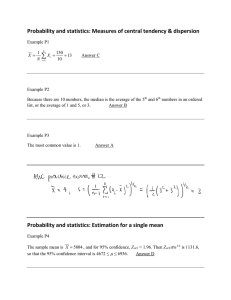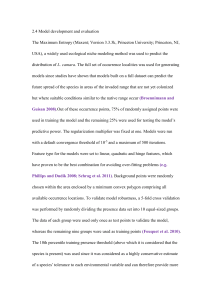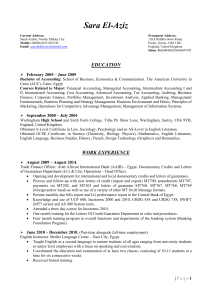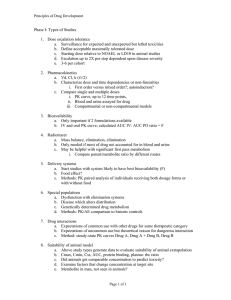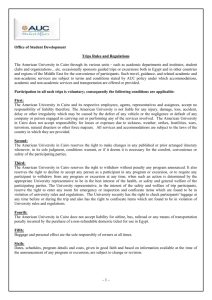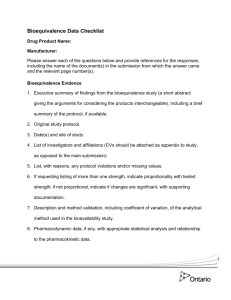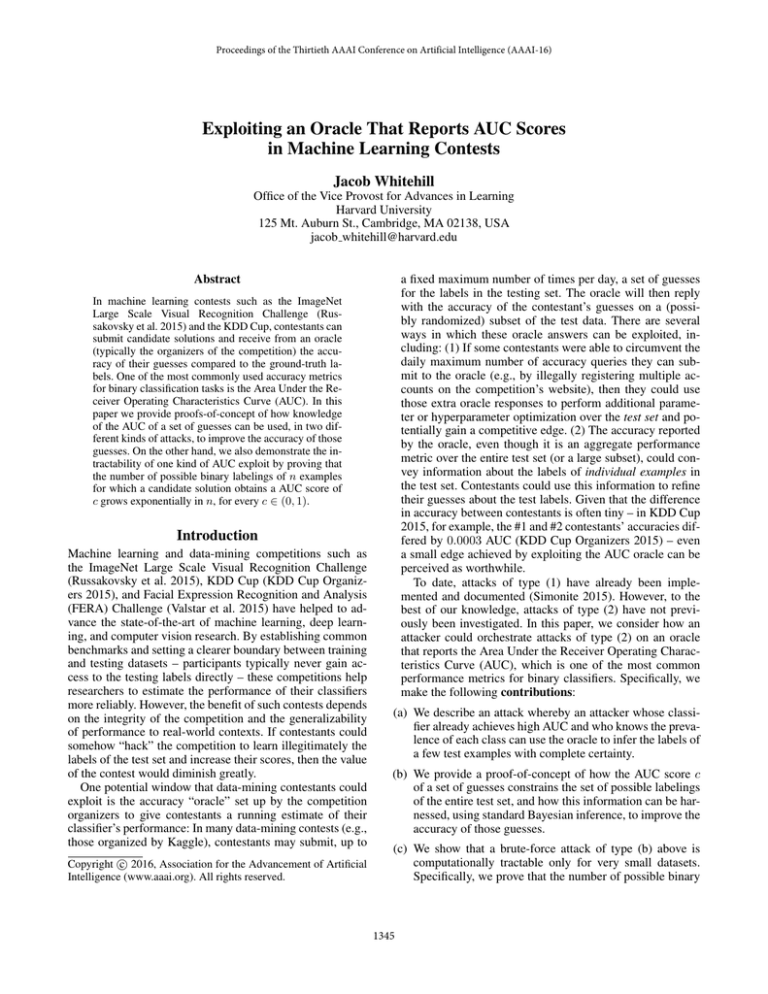
Proceedings of the Thirtieth AAAI Conference on Artificial Intelligence (AAAI-16)
Exploiting an Oracle That Reports AUC Scores
in Machine Learning Contests
Jacob Whitehill
Office of the Vice Provost for Advances in Learning
Harvard University
125 Mt. Auburn St., Cambridge, MA 02138, USA
jacob whitehill@harvard.edu
a fixed maximum number of times per day, a set of guesses
for the labels in the testing set. The oracle will then reply
with the accuracy of the contestant’s guesses on a (possibly randomized) subset of the test data. There are several
ways in which these oracle answers can be exploited, including: (1) If some contestants were able to circumvent the
daily maximum number of accuracy queries they can submit to the oracle (e.g., by illegally registering multiple accounts on the competition’s website), then they could use
those extra oracle responses to perform additional parameter or hyperparameter optimization over the test set and potentially gain a competitive edge. (2) The accuracy reported
by the oracle, even though it is an aggregate performance
metric over the entire test set (or a large subset), could convey information about the labels of individual examples in
the test set. Contestants could use this information to refine
their guesses about the test labels. Given that the difference
in accuracy between contestants is often tiny – in KDD Cup
2015, for example, the #1 and #2 contestants’ accuracies differed by 0.0003 AUC (KDD Cup Organizers 2015) – even
a small edge achieved by exploiting the AUC oracle can be
perceived as worthwhile.
To date, attacks of type (1) have already been implemented and documented (Simonite 2015). However, to the
best of our knowledge, attacks of type (2) have not previously been investigated. In this paper, we consider how an
attacker could orchestrate attacks of type (2) on an oracle
that reports the Area Under the Receiver Operating Characteristics Curve (AUC), which is one of the most common
performance metrics for binary classifiers. Specifically, we
make the following contributions:
Abstract
In machine learning contests such as the ImageNet
Large Scale Visual Recognition Challenge (Russakovsky et al. 2015) and the KDD Cup, contestants can
submit candidate solutions and receive from an oracle
(typically the organizers of the competition) the accuracy of their guesses compared to the ground-truth labels. One of the most commonly used accuracy metrics
for binary classification tasks is the Area Under the Receiver Operating Characteristics Curve (AUC). In this
paper we provide proofs-of-concept of how knowledge
of the AUC of a set of guesses can be used, in two different kinds of attacks, to improve the accuracy of those
guesses. On the other hand, we also demonstrate the intractability of one kind of AUC exploit by proving that
the number of possible binary labelings of n examples
for which a candidate solution obtains a AUC score of
c grows exponentially in n, for every c ∈ (0, 1).
Introduction
Machine learning and data-mining competitions such as
the ImageNet Large Scale Visual Recognition Challenge
(Russakovsky et al. 2015), KDD Cup (KDD Cup Organizers 2015), and Facial Expression Recognition and Analysis
(FERA) Challenge (Valstar et al. 2015) have helped to advance the state-of-the-art of machine learning, deep learning, and computer vision research. By establishing common
benchmarks and setting a clearer boundary between training
and testing datasets – participants typically never gain access to the testing labels directly – these competitions help
researchers to estimate the performance of their classifiers
more reliably. However, the benefit of such contests depends
on the integrity of the competition and the generalizability
of performance to real-world contexts. If contestants could
somehow “hack” the competition to learn illegitimately the
labels of the test set and increase their scores, then the value
of the contest would diminish greatly.
One potential window that data-mining contestants could
exploit is the accuracy “oracle” set up by the competition
organizers to give contestants a running estimate of their
classifier’s performance: In many data-mining contests (e.g.,
those organized by Kaggle), contestants may submit, up to
c 2016, Association for the Advancement of Artificial
Copyright Intelligence (www.aaai.org). All rights reserved.
(a) We describe an attack whereby an attacker whose classifier already achieves high AUC and who knows the prevalence of each class can use the oracle to infer the labels of
a few test examples with complete certainty.
(b) We provide a proof-of-concept of how the AUC score c
of a set of guesses constrains the set of possible labelings
of the entire test set, and how this information can be harnessed, using standard Bayesian inference, to improve the
accuracy of those guesses.
(c) We show that a brute-force attack of type (b) above is
computationally tractable only for very small datasets.
Specifically, we prove that the number of possible binary
1345
labelings of n examples for which a candidate solution
obtains a AUC score of c grows exponentially in n, for
every c ∈ (0, 1).
As the importance and prominence of data-mining competitions continue to increase, attackers will find more and more
ingenious methods of hacking them. The greater goal of this
paper is to raise awareness of this potential danger.
Area Under the ROC Curve (AUC) is then the integral of
the ROC curve over the interval [0, 1].
An alternative but equivalent interpretation of the AUC
(Tyler and Chen 2000; Agarwal et al. 2005), which we use
in this paper, is that it is equal to the probability of correct response in a 2-Alternative Forced-Choice (2AFC) task,
whereby the classifier’s real-valued outputs are used to discriminate between one positively labeled and one negatively
labeled example drawn from the set of all such pairs in the
test set. If the AUC is 1, then the classifier can discriminate
between a positive and a negative example perfectly (i.e.,
with probability 1). A classifier that guesses randomly has
AUC of 0.5. Using this probabilistic definition, given the
.
ground-truth labels y1:n = y1 , . . . , yn and the classifier’s
.
real-valued guesses ŷ1:n = ŷ1 , . . . , ŷn , we can define the
function f to compute the AUC of the guesses as:
Related Work
Our work is related to the problem of data leakage, which
is the inadvertent introduction of information about test data
into the training dataset of data-mining competitions. Leakage has been named one of the most important data-mining
mistakes (Miner, Nisbet, and Elder IV 2009) and can be surprisingly insidious and difficult to identify and prevent (Kohavi et al. 2000; Kaufman et al. 2012). Leakage has traditionally been defined in a “static” sense, e.g., an artifact of
the data preparation process that causes certain features to
reveal the target label with complete certainty. The exploitation of an AUC oracle can be seen as a form of “dynamic”
leakage: the oracle’s AUC response during the competition
to a set of guesses submitted by a contestant can divulge the
identity of particular test labels or at least constrain the set
of possible labelings.
Our research also relates to privacy-preserving machine
learning and differential privacy (e.g., (Dwork 2011; Chaudhuri and Monteleoni 2009; Blum, Ligett, and Roth 2013)),
which are concerned with how to provide useful aggregate
statistics about a dataset – e.g., the mean value of a particular attribute, or even a hyperplane to be used for classifying the data – without disclosing private information about
particular examples within the dataset. Stoddard, Chen, and
Machanavajjhala (2014), for example, proposed an algorithm for computing “private ROC” curves and associated
AUC statistics. The prior work most similar to ours is by
Matthews and Harel (2013), who show how an attacker who
already knows most of the test labels can estimate the remaining labels if he/she gains access to an empirical ROC
curve, i.e., a set of classifier thresholds and corresponding
true positive and false positive rates. In a simulation on
100 samples, they show how a simple Markov-chain Monte
Carlo algorithm can recover the remaining 10% of missing
test labels, with high accuracy, if 90% of the test labels are
already known.
f (y1:n , ŷ1:n )
1
1 .
I[ŷi < ŷj ] + I[ŷi = ŷj ]
=
n0 n1
2
−
+
i∈Y
j∈Y
In this paper, we will assume that the classifier’s guesses
ŷ1 , . . . , ŷn are all distinct (i.e., ŷi = ŷj ⇐⇒ i = j), which
in many classification problems is common. In this case, the
formula above simplifies to:
1 .
f (y1:n , ŷ1:n ) =
I[ŷi < ŷj ] (1)
n0 n1
−
+
i∈Y
j∈Y
As is evident in Eq. 1, all that matters to the AUC is the
relative ordering of the ŷi , not their exact values. Also, if
all examples belong to the same class and either n1 = 0 or
n0 = 0, then the AUC is undefined. Finally, the AUC is a
rational number because it can be written as the fraction of
two integers p and q. We use these facts later in the paper.
Exploiting the AUC Score: A Simple Example
As a first example of how knowing the AUC of a set of
guesses can reveal the ground-truth test labels, consider
a hypothetical tiny test set of just 4 examples such that
yi ∈ {0, 1} is the ground-truth label for example i ∈
{1, 2, 3, 4}. Suppose a contestant estimates, through some
machine learning process, that the probabilities that these
examples belong to the positive class are ŷ1 = 0.5, ŷ2 = 0.6,
ŷ3 = 0.9, and ŷ4 = 0.4, and that the contestant submits these guesses to the oracle. If the oracle replies that
these guesses have an AUC of 0.75, then the contestant can
conclude with complete certainty that the true solution is
y1 = 1, y2 = 0, y3 = 1, and y4 = 0 because this is
the only ground-truth labeling satisfying Eq. 1 (see Table
1). The contestant can then revise his/her guesses based on
the information returned by the oracle and receive a perfect
score. Interestingly, in this example, the fact that the AUC
is 0.75 is even more informative than if the AUC of the initial guesses were 1, because the latter is satisfied by three
different ground-truth labelings.
This simple example raises the question of whether
knowledge of the AUC could be exploited in more general
cases. In the next sections we explore two possible attacks
that a contestant might wage.
ROC, AUC, and 2AFC
One of the most common ways to quantify the performance
of a binary classifier is the Receiver Operating Characteristics (ROC) curve. Suppose a particular test set has groundtruth labels y1 , . . . , yn ∈ {0, 1} and the classifier’s guesses
for these labels are ŷ1 , . . . , ŷn ∈ R. For any fixed threshold θ ∈ R,the false positive rate of these guesses is
.
FP(θ) = n10 i∈Y − I[ŷi ≥ θ] and the true positive rate is
. 1 TP(θ) = n1 i∈Y + I[ŷi ≥ θ], where I[·] ∈ {0, 1} is an indicator function, Y − = {i : yi = 0} and Y + = {i : yi = 1}
are the index sets of the negatively and positively labeled examples, and n0 = |Y − |, n1 = |Y + |. The ROC curve is constructed by plotting (FP(θ), TP(θ)) for all possible θ. The
1346
AUC for different labelings
y1 y 2 y3 y 4
AUC
0
0
0
0
–
0
0
0
1
0.00
0
0
1
0
1.00
0
0
1
1
0.50
0
1
0
0
≈ 0.67
0
1
0
1
0.25
1
1
0
1.00
0
0
1
1
1
≈ 0.67
1
0
0
0
≈ 0.33
1
0
0
1
0.00
1
0
1
0
0.75
1
0
1
1
≈ 0.33
1
1
0
0
0.50
1
1
0
1
0.00
1
1
1
0
1.00
1
1
1
1
–
Proof. Without loss of generality, suppose that the indices
are arranged such that the ŷi are sorted, i.e., ŷ1 < . . . < ŷn .
Suppose, by way of contradiction, that m of the first k examples were positively labeled, where 1 ≤ m ≤ k. For each
such possible m, we can find at least m(n0 −k) pairs that are
misclassified according to the real-valued guesses by pairing
each of the m positively labeled examples within the index
range {i : 1 ≤ i ≤ k} with each of (n0 − k) negatively labeled examples within the index range {j : k +1 ≤ j ≤ n}.
In each such pair (i, j), yi = 1 and yj = 0, and yet ŷi < ŷj ,
and thus the pair is misclassified. The minimum number of
misclassified pairs, over all m in the range {1, . . . , k}, is
clearly n0 − k (for m = 1). Since there are n0 n1 total pairs
in D consisting of one positive and one negative example,
and since the AUC is maximized when the number of misclassified pairs is minimized, then the maximum AUC that
could be achieved when m ≥ 1 of the first k examples are
positively labeled is
1
k
n0 − k
=1−
+
1−
n0 n1
n1
n0 n1
But this is less than c. We must therefore conclude that m =
0, i.e., all of the first k examples are negatively labeled.
The proof is exactly analogous for the case when c >
1 − n10 + n0kn1 .
Table 1: Accuracy (AUC) achieved when a contestant’s
real-valued guesses of the test labels are ŷ1 = 0.5, ŷ2 =
0.6, ŷ3 = 0.9, ŷ4 = 0.4, shown for each possible groundtruth labeling. Only for one possible labeling (highlighted)
do the contestant’s guesses achieve AUC of exactly 0.75.
Example
Attack 1: Deducing Highest/Lowest-Ranked
Labels with Certainty
Suppose that a contestant’s real-valued guesses ŷ1 , . . . , ŷn
achieve an AUC of c = 0.985 on a dataset containing n0 =
45 negative and n1 = 55 positive examples, and that n0 and
n1 are known to him/her. Then the contestant can conclude
that the labels of the first (according to the rank order of
ŷ1 , . . . , ŷn ) 7 examples must be negative and the labels of
the last 17 examples must be positive.
In this section we describe how a contestant, whose guesses
are already very accurate (AUC close to 1), can orchestrate
an attack to infer a few of the test set labels with complete
certainty. This could be useful for several reasons: (1) Even
though the attacker’s AUC is close to 1, he/she may not
know the actual test set labels – see Table 1 for an example.
If the same test examples were ever re-used in a subsequent
competition, then knowing their labels could be helpful. (2)
Once the attacker knows some of the test labels with certainty, he/she can now use these examples for training. This
can be especially beneficial when the test set is drawn from
a different population than the training set (e.g., different set
of human subjects’ face images (Valstar et al. 2011)). (3) If
multiple attackers all score a high AUC but have very different sets of guesses, then they could potentially collude to
infer the labels of a large number of test examples.
The attack requires rather strong prior knowledge of the
exact number of positive and negative examples in the test
set (n1 and n0 , respectively).
Proposition 1. Let D be a dataset with labels y1 , . . . , yn , of
which n0 are negative and n1 are positive. Let ŷ1 , . . . , ŷn be
a contestant’s real-valued guesses for the labels of D such
that ŷi = ŷj ⇐⇒ i = j. Let c = f (y1:n , ŷ1:n ) denote the
AUC achieved by the real-valued guesses with respect to the
ground-truth labels. For any positive integer k ≤ n0 , if c >
1− n11 + n0kn1 , then the first k examples according to the rank
order of ŷ1 , . . . , ŷn must be negatively labeled. Similarly, for
any positive integer k ≤ n1 , if c > 1 − n10 + n0kn1 , then the
last k examples according to the rank order of ŷ1 , . . . , ŷn
must be positively labeled.
Attack 2: Integration over Satisfying Solutions
The second attack that we describe treats the AUC reported
by the oracle as an observed random variable in a standard
supervised learning framework. In contrast to Attack 1, no
prior knowledge of n0 or n1 is required. Note that the attack
we describe uses only a single oracle query to improve an existing set of real-valued guesses. More sophisticated attacks
might conceivably refine the contestant’s guesses in an iterative fashion using multiple queries. Notation: In this section
only, capital letters denote random variables and lower-case
letters represent instantiated values.
Consider the graphical model of Fig. 1, which depicts a
test set containing n examples where each example i is described by a vector Xi ∈ Rm of m features (e.g., image
pixels). Under the model, each label Yi ∈ {0, 1} is generated according to P (Yi = 1 | xi , θ) = g(xi , θ), where
g : Rm × Rm → [0, 1] could be, for example, the sigmoid
function of logistic regression and θ ∈ Rm is the classifier
parameter. Note that this is a standard probabilistic discriminative model – the only difference is that we have created
an intermediate variable Ŷi ∈ [0, 1] to represent g(xi , θ) explicitly for each i. Specifically, we define:
P (ŷi | xi , θ) = δ(ŷi − g(xi , θ))
P (Yi = 1 | ŷi ) = ŷi
1347
ᶚ
;
;Q
)HDWXUHV
Ǔ
ǓQ
*XHVVHV
<
<Q
7UXHODEHOV
&ODVVLILHU
SDUDPHWHUOHDUQW
RQWUDLQLQJGDWD
$FFXUDF\$8&
UHSRUWHGE\RUDFOH
&
Figure 1: Without node C, this graphical model shows a
standard supervised learning problem: after estimating θ (on
training data, not shown), the test labels Y1 , . . . , Yn can be
estimated from feature vectors X1 , . . . , Xn , and then submitted to the organizers of the competition. Node C represents the contestant’s accuracy (AUC), which is often provided by an oracle and can be leveraged to improve the
guesses for the test set labels. Only the shaded variables are
observed.
Figure 2: Tiny simulation of how exploiting knowledge of
the AUC of a set of guesses can improve accuracy, as a function of existing accuracy.
In other words, to compute the (unnormalized) posterior probability that Yi = yi given C = c, simply find all label assignments to the other variables
the AUC is c, and then
Y1 , . . . , Yi−1 , Yi+1 , . . . , Yn such that
compute the sum of the likelihoods j P (yj | ŷj ) over all
such assignments.
where δ is the Dirac delta function.
The classification parameter θ can be estimated from
training data (not shown), and thus we consider it to be observed. Using X1:n and an estimate for θ, the contestant can
then compute Ŷ1:n and submit these as his/her guesses to the
competition organizers. The question is: if the competition
allows access to an oracle that reports C (i.e., variable C
is observed), how can this additional information be used?
Since the AUC C is a deterministic function (Eq. 1) of y1:n
and ŷ1:n , we have:
Simulation
As a proof-of-concept of the algorithm described above, we
conducted a simulation on a tiny dataset of n = 16 examples. In particular, we let g(x, θ) = (1 + exp(−θ x))−1
(sigmoid function for logistic regression), and we sampled
θ and X1 , . . . , Xn from an m-dimensional Normal distribution with zero mean and diagonal unit covariance. In our
simulations, the contestant does not know the value of θ but
can estimate it from a training dataset containing k examples
(with L2 regularization of 1). In each simulation, the contestant computes Ŷ1:n from its estimate of θ and the feature
vectors X1:n . The contestant then submits Ŷ1:n as guesses
to the oracle, receives the AUC score C, and then computes
P (Y1 = 1 | ŷ1:n , c), . . . , P (Yn = 1 | ŷ1:n , c). The contestant then submits these posterior probabilities as its second
set of guesses and receives an updated AUC score C . After
each simulation run, we record the accuracy gain C − C.
By varying k ∈ {1, . . . , 20}, m ∈ {4, 5, . . . , 16}, and averaging over 50 simulation runs per (m, k) combination, we
can then compute the expected accuracy gain ΔAU C (i.e.,
C − C) as a function of the initial AUC (C).
Results: The graph in Fig. 2 indicates that, for a wide
range of starting AUC values C, a small but worthwhile
average increase in accuracy can be achieved, particularly
when C is closer to 0.5.
P (c | y1:n , ŷ1:n ) = δ(f (y1:n , ŷ1:n ) − c)
Then, according to standard Bayesian inference, the contestant can use C to update his/her posterior estimate of each
label Yi as follows:
P (yi | ŷ1:n , c)
P (y1:n | ŷ1:n , c)
=
y¬i
=
∝
where y¬i refers to y1 , . . . , yi−1 , yi+1 , . . . , yn .
P (c | y1:n , ŷ1:n )P (y1:n | ŷ1:n )
P (c | ŷ1:n )
y¬i
⎡
⎤
⎣P (c | y1:n , ŷ1:n )
P (yj | ŷj )⎦
y¬i
=
y¬i
=
j
δ(f (y1:n , ŷ1:n ) − c)
y¬i :
j
f (y1:n , ŷ1:n ) = c
P (yj | ŷj )
j
P (yj | ŷj )
Tractability
(2)
In the simulation above, we used a brute-force approach
when solving Eq. 2: we created a list of all 2n possible bi-
1348
nary tuples (y1 , . . . , yn ) and then simply selected those tuples that satisfied f (y1:n , ŷ1:n ) = c. However, if the number
of such tuples were small, and if one could efficiently enumerate over them, then the attack would become much more
practical. This raises an important question: for a dataset of
size n and a fixed set of real-valued guesses ŷ1 , . . . , ŷn , are
there certain AUC values for which the number of possible
binary labelings is sub-exponential in n? We investigate this
question in the next section.
in the following sense: for each i ∈ {2(2p − q) + 1, . . . , 4q},
yi = 1 ⇐⇒ yj = 1 where j = 2(2p − q) + (4q − i + 1).
Given this construction, we must calculate how many
pairs containing one positive and one negative example are
correctly and incorrectly classified. Note that each of the first
2(2p − q) negative examples in the left band can be paired
with each of the 2q positive examples in the right band, and
that each of these positive examples has a higher ŷ value than
the negative examples; hence, each of these 2q(2)(2p−q) =
8pq − 4q 2 pairs is classified correctly. The only remaining
pairs of examples occur within the right band. To calculate
the number of correctly/incorrectly classified pairs in the
right band, we exploit the fact that it is symmetric: For any
index pair (i, j) where i, j ∈ {2(2p − q) + 1, . . . , 4q}, where
yi = 0 and yj = 1, and where i < j (and hence ŷi < ŷj ), we
can find exactly one other pair (i , j ) for which yi = 0 and
yj = 1 and for which i > j . Hence, within the right band,
the numbers of correctly and incorrectly classified pairs are
equal. Since there are 2q(4)(q − p) = 8q 2 − 8pq pairs within
this band total, then 4q 2 − 4pq are classified correctly and
4q 2 − 4pq are classified incorrectly.
Summing the pairs of examples within the right band and
the pairs between the left and right bands, we have 8pq −
4q 2 + 8q 2 − 8pq = 4q 2 pairs total. The number of correctly
classified pairs is 4q 2 − 4pq + 8pq − 4q 2 = 4pq, and thus
the AUC is 4pq/(4q 2 ) = p/q = c, as desired.
Now that we have constructed a single labeling of size
n = 4q for which the AUC is c, we can construct many
more simply by varying the positions of the 2q positive entries within the right band of 2(3q − 2p) entries. To preserve
symmetry, we can vary the positions of half of the positive
examples within half of the right band and then simply “reflect” the positions onto the other half. In total, the number
of choices is:
3q − 2p
q
(3q − 2p)!
=
q!(3q − 2p − q)!
(3q − 2p)!
=
q!(2q − 2p)!
(3q − 2p)(3q − 2p − 1) · · · (2q − 2p + 1)
=
q(q − 1) · · · (2)(1)
The Number of Satisfying Solutions Grows
Exponentially in n for Every AUC c ∈ (0, 1)
In this section we prove that the number of tuples
(y1 , . . . , yn ) for which a contestant’s guesses achieve a fixed
AUC c grows exponentially in n, for every c ∈ (0, 1).
(Note that this is different from proving that, for a dataset
of some fixed size n, the number of tuples (y1 , . . . , yn ) for
which a contestant’s guesses achieve some AUC c is exponential in n.) Our proof is by construction: for any AUC
c = pq , p, q ∈ Z+ , p < q, we show how to construct a
dataset of size n = 4q such that the number of satisfying
n/4
binary labelings is at least (2 − 2 |c − 0.5|) . Intuitively,
this lower-bound grows more quickly for AUC values close
to 0.5 than for AUC values close to 0 or 1.
First, we prove a simple lemma:
Lemma 1. Let a, b, c ∈ Z such that a > b > 0 and c ≥ 0.
a
Then a+c
b+c ≤ b .
Proof. By way of contradiction, suppose
(a + c)b
ab + bc
bc
a+c
b+c
> ab . Then
> a(b + c)
> ab + ac
> ac
which is clearly false (for c = 0) or implies b > a (for
c > 0).
Proposition 2. Let D be a dataset consisting of n = 4q
examples for some q ∈ Z+ , and let ŷ1 , . . . , ŷn be a contestant’s real-valued guesses for the binary labels of D such
that ŷi = ŷj ⇐⇒ i = j. Then for any AUC c such that
c = pq , p, q ∈ Z+ and p < q, the number of distinct binary
labelings y1 , . . . , yn for which f (y1:n , ŷ1:n ) = c is at least
n/4
(2 − 2 |c − 0.5|) .
We now apply Lemma 1 and the fact that the numerator and
denominator both contain q terms:
3q − 2p
q
q
3q − 2p
≥
q
n/4
3q − 2p
=
q
Proof. Without loss of generality, suppose that the indices
are arranged such that the ŷi are sorted, i.e., ŷ1 < . . . < ŷn .
Since the AUC is invariant under monotonic transformations
of the real-valued guesses, we can represent each ŷi simply
by its index i. Since c is a fraction of pairs that are correctly
classified, we can write it as p/q for positive integers p, q.
We will handle the cases c ≥ 0.5 and c < 0.5 separately.
Case 1 (0.5 ≤ c < 1): Construct a dataset of size n = 4q
as shown in Fig. 3: the first 2(2p − q) entries are negative
examples, and of the remaining 2(3q − 2p) entries (which
we call the “right band”), 2q are positive and 4(q − p) are
negative. Moreover, the right band is arranged symmetrically
=
1349
(3 − 2c)
n/4
*XHVVǔ
/DEHO\
ST
T
T
TS
/HIWEDQG
TS
T
5LJKWEDQG
Figure 3: Construction of a binary labeling for which the AUC is c, for any c =
Case 2 (0 < c < 0.5): The proof is analogous except that
we “flip” the AUC around 0.5 and correspondingly “flip” the
labels left-to-right. Let r = q − p (so that r/q = 1 − p/q).
Then, we form a similar construction as above, except that
the left sequence of all negative examples is moved to the
right. Specifically, we create a symmetric sequence of length
2(3q − 2r) such that 2q examples are positive and 4(q − r)
are negative. We then append 2(2r − q) entries to the right
that are all negative. This results in
1
(2q × 4(q − r)) = 4q 2 − 4qr
2
pairs that are classified correctly and
1
2(2r − q) × 2q + (2q × 4(q − r))
2
= 8qr − 4q 2 + 4q 2 − 4qr
= 4qr
(1 + 2c)
p
q
such that 0.5 ≤ c < 1.
a data-mining contest to exploit an oracle that reports AUC
scores to illegitimately attain higher performance. We presented two simple attacks: one whereby a contestant whose
guesses already achieve high accuracy can infer, with complete certainty, the values of a few of the test set labels;
and another whereby a contestant can harness the oracle’s
AUC information to improve his/her guesses using standard
Bayesian inference. To our knowledge, our paper is the first
to formally investigate these kinds of attacks.
The practical implications of our work are mixed: On the
one hand, we have provided proofs-of-concept that systematic exploitation of AUC oracles is possible, which underlines the importance of taking simple safeguards such as
(a) adding noise to the output of the oracle, (b) limiting
the number of times that a contestant may query the oracle; (c) not re-using test examples across competitions; and
(d) not revealing any information about the numbers of positive/negative examples in the test set. On the other hand,
we also provided evidence – in the form of a proof that the
number of binary labelings for which a set of guesses attains an AUC of c grows exponentially in the test set size n
– that brute-force probabilistic inference to improve one’s
guesses is intractable except for tiny datasets. It is conceivable that some approximate inference algorithms might
overcome this obstacle.
As data-mining contests continue to grow in number and
importance, it is likely that more creative exploitation – e.g.,
attacks that harness multiple oracle queries instead of just
single queries – will be attempted. It is even possible that
the focus of effort in such contests might shift from developing effective machine learning classifiers to querying the
oracle strategically, without training a useful classifier at all.
With our paper we hope to highlight an important potential
problem in the machine learning community.
pairs that are classified incorrectly. In total, there are 4qr +
4q 2 −4qr = 4q 2 pairs, so that the AUC is (4q 2 −4qr)/4q 2 =
1 − r/q = p/q, as desired.
Analogously to above, we can form
3q − 2r
(3q − 2r)!
=
q
q!(2q − 2r)!
n/4
3q − 2r
≥
q
n/4
3q − 2(q − p)
=
q
n/4
q + 2p
=
q
=
n/4
References
symmetric constructions of the left band.
Combining Case 1 and Case 2, we find that the number of
binary labelings for which the AUC is c is at least
Agarwal, S.; Graepel, T.; Herbrich, R.; Har-Peled, S.; and
Roth, D. 2005. Generalization bounds for the area under
the ROC curve. In Journal of Machine Learning Research,
393–425.
n/4
(2 − 2 |c − 0.5|)
for all 0 < c < 1.
Blum, A.; Ligett, K.; and Roth, A. 2013. A learning theory
approach to noninteractive database privacy. Journal of the
ACM (JACM) 60(2):12.
Conclusion
In this paper we have examined properties of the Area Under the ROC Curve (AUC) that can enable a contestant of
Chaudhuri, K., and Monteleoni, C. 2009. Privacy-preserving
1350
logistic regression. In Advances in Neural Information Processing Systems, 289–296.
Dwork, C. 2011. Differential privacy. In van Tilborg, H.,
and Jajodia, S., eds., Encyclopedia of Cryptography and Security. Springer US. 338–340.
Kaufman, S.; Rosset, S.; Perlich, C.; and Stitelman, O. 2012.
Leakage in data mining: Formulation, detection, and avoidance. ACM Transactions on Knowledge Discovery from
Data (TKDD) 6(4):15.
KDD Cup Organizers. 2015. https://www.kddcup2015.com/
submission-rank.html.
Kohavi, R.; Brodley, C. E.; Frasca, B.; Mason, L.; and
Zheng, Z. 2000. Kdd-cup 2000 organizers’ report: Peeling
the onion. ACM SIGKDD Explorations Newsletter 2(2):86–
93.
Matthews, G. J., and Harel, O. 2013. An examination of data
confidentiality and disclosure issues related to publication of
empirical roc curves. Academic radiology 20(7):889–896.
Miner, G.; Nisbet, R.; and Elder IV, J. 2009. Handbook of
statistical analysis and data mining applications. Academic
Press.
Russakovsky, O.; Deng, J.; Su, H.; Krause, J.; Satheesh, S.;
Ma, S.; Huang, Z.; Karpathy, A.; Khosla, A.; Bernstein, M.;
Berg, A. C.; and Fei-Fei, L. 2015. ImageNet Large Scale Visual Recognition Challenge. International Journal of Computer Vision (IJCV) 1–42.
Simonite, T. 2015. Why and how Baidu cheated an artificial
intelligence test. MIT Technology Review.
Stoddard, B.; Chen, Y.; and Machanavajjhala, A. 2014. Differentially private algorithms for empirical machine learning. CoRR abs/1411.5428.
Tyler, C., and Chen, C.-C. 2000. Signal detection theory
in the 2AFC paradigm: attention, channel uncertainty and
probability summation. Vision Research 40(22):3121–3144.
Valstar, M. F.; Jiang, B.; Méhu, M.; Pantic, M.; and Scherer,
K. 2011. The first facial expression recognition and analysis
challenge. In Proceedings of the IEEE International Conference on Automatic Face and Gesture Recognition.
Valstar, M.; Girard, J.; Almaev, T.; McKeown, G.; Mehu,
M.; Yin, L.; Pantic, M.; and Cohn, J. 2015. Fera 2015second facial expression recognition and analysis challenge.
Proc. IEEE ICFG.
1351

